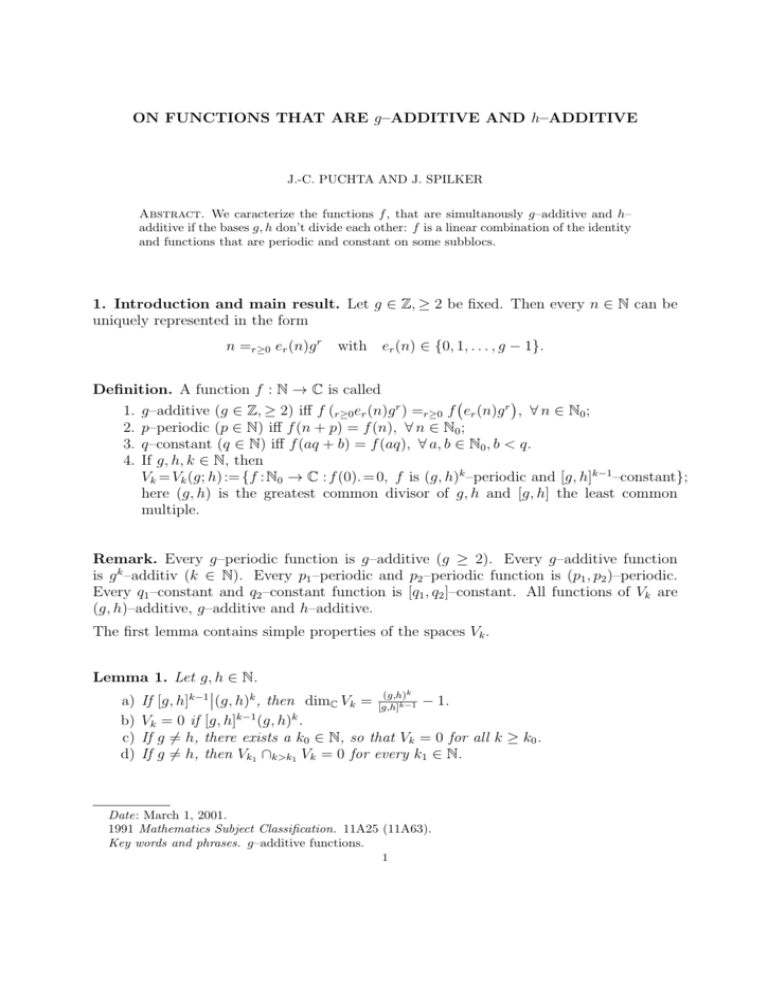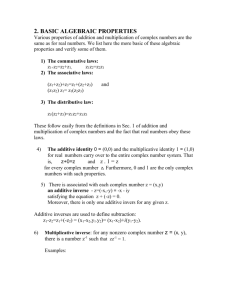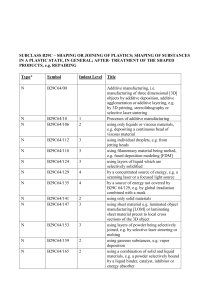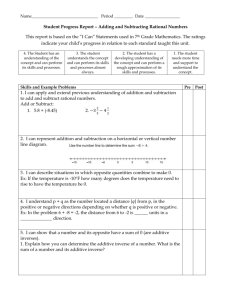ON FUNCTIONS THAT ARE g–ADDITIVE AND h–ADDITIVE 1
advertisement

ON FUNCTIONS THAT ARE g–ADDITIVE AND h–ADDITIVE
J.-C. PUCHTA AND J. SPILKER
Abstract. We caracterize the functions f , that are simultanously g–additive and h–
additive if the bases g, h don’t divide each other: f is a linear combination of the identity
and functions that are periodic and constant on some subblocs.
1. Introduction and main result. Let g ∈ Z, ≥ 2 be fixed. Then every n ∈ N can be
uniquely represented in the form
n =r≥0 er (n)g r
with er (n) ∈ {0, 1, . . . , g − 1}.
Definition. A function f : N → C is called
1. g–additive (g ∈ Z, ≥ 2) iff f (r≥0 er (n)g r ) =r≥0 f er (n)g r , ∀ n ∈ N0 ;
2. p–periodic (p ∈ N) iff f (n + p) = f (n), ∀ n ∈ N0 ;
3. q–constant (q ∈ N) iff f (aq + b) = f (aq), ∀ a, b ∈ N0 , b < q.
4. If g, h, k ∈ N, then
Vk = Vk (g; h) := {f : N0 → C : f (0). = 0, f is (g, h)k –periodic and [g, h]k−1 –constant};
here (g, h) is the greatest common divisor of g, h and [g, h] the least common
multiple.
Remark. Every g–periodic function is g–additive (g ≥ 2). Every g–additive function
is g k –additiv (k ∈ N). Every p1 –periodic and p2 –periodic function is (p1 , p2 )–periodic.
Every q1 –constant and q2 –constant function is [q1 , q2 ]–constant. All functions of Vk are
(g, h)–additive, g–additive and h–additive.
The first lemma contains simple properties of the spaces Vk .
Lemma 1. Let g, h ∈ N.
(g,h)k
a) If [g, h]k−1 (g, h)k , then dimC Vk = [g,h]
k−1 − 1.
k−1
k
b) Vk = 0 if [g, h] (g, h) .
c) If g 6= h, there exists a k0 ∈ N, so that Vk = 0 for all k ≥ k0 .
d) If g 6= h, then Vk1 ∩k>k1 Vk = 0 for every k1 ∈ N.
Date: March 1, 2001.
1991 Mathematics Subject Classification. 11A25 (11A63).
Key words and phrases. g–additive functions.
1
2
J.-C. PUCHTA AND J. SPILKER
Proof. a) Every f ∈ Vk is uniquely determined by the values a[g, h]k−1 , 1 ≤ a <
and these values can be arbitrarily given.
(g,h)k
,
[g,h]k−1
b) If f 6= 0 is p–periodic, q–constant, f (0) = 0 and m := min{n ∈ N : f (n) 6= 0}, then
q|m, q|m + p, hence q|p.
c) Choose k0 such, that (g, h)k0 < [g, h]k0 −1 .
d) Every f ∈ Vk1 ∩k>k1 Vk is (g, h)k1 –periodic and has the property f (n) = 0 for all
0 ≤ n < [g, h]k1 , so f = 0.
Examples.
1) If (g, h) = 1, then Vk (g; h) = 0, ∀ k ≥ 1.
2) If g has a prime–factor, that does not divide h, then Vk (g; h) = 0, ∀ k ≥ 2.
3) The space V2 (24; 36) contains the function
0 n ≡ a mod 144(0 ≤ a < 72)
f (n) =
1 n ≡ b mod 144(72 ≤ b < 144).
Our main result is the following
Theorem. Let g, h be integers ≥ 2 and assume gh, hg. Then
(1) every function f , that is simultanously g–additive and h–additive, can be uniquely
represented in the form
f = c · id +1≤k≤k0 fk ,
where c ∈ C, fk ∈ Vk (g; h).
(2) The complex vectorspace V of all these functions has dimension
X
(g, h)k
dimC V = 1 +
dk , dk :=
− 1,
[g, h]k−1
where we sum over the natural k with [g, h]k−1 (g, h)k .
(3) Every g– and h– additive function is already (g, h)–additive, if (g, h) > 1.
log g
Remark. We suppose that log
is irrational. Then there exist natural l, m so that
h
l m
m l
g h , h g . It follows from the theorem, that the space V of all g–additive and h–
additive functions has finite dimension and every function of V is (g l , hm )–additiv, if
(g l , hm ) > 1. If k0 is chosen so that Vk (g l ; hm ) = 0, ∀ k ≥ k0 , and if fk ∈ Vk (g l ; hm ), then
fk (dn) = fk (0) = 0, where d := (g l , hm )k0 , so f (dn) = cn for every natural n.
a) If in addition g, h are coprime, on can choose k0 = 1 and every f ∈ V has the
form f (n) = cn. This was proved by Uchida [2, theorem 1] by another method.
b) If f has the property f (eg r ) = f (e), 0 ≤ e < g, r ≥ 0 (”strongly g–additive”),
then the theorem gives f = 0, so every strongly g–additive and h–additive function
vanishes if g 6 |h and h 6 |g. This is a result of Toshimitsu [1, theorem 3].
2.
Lemmata.
If f : N0
∆f (n) := f (n) − f (n − 1), n ≥ 1.
→
C, we consider the difference function
3
Lemma 2. If f is g–additive, then
∆f (n + g) = ∆f (n),
if n 6≡ 0(modg).
Proof. Let n ∈ N0 , say n =r≥0 er (n)g r . Then if gn.
er (n) = er (n − 1), er (n + g) = er (n − 1 + g),
r≥1
e0 (n) = e0 (n + g), e0 (n − 1) = e0 (n − 1 + g)
and so
∆f (n) = f e0 (n) − f e0 (n − 1)
= f e0 (n + g) − f e0 (n − 1 + g)
= ∆f (n + g).
Lemma 3. Let g, h ∈ N, gh, hg and the function F : N → C have the properties
F (n + g) = F (n), if n 6≡ 0(mod g),
F (n + h) = F (n), if n 6≡ 0(mod h).
Then there are functions P, Q : N → C so that
a) F = P + Q;
b) P is (g, h)–periodic;
c) Q(n) = 0, if n 6≡ 0 (mod [g, h]).
Proof. Let P be the (g, h)–periodic function defined by P (n)
= F (n), 1 ≤ n ≤ (g, h) and
Q := F − P . We have to prove c). Given n 6≡ 0 mod [g, h] , we distinguish two cases.
1. case (g, h)n: choose k, l ∈ Z so that kg + lh = (g, h); suppose k > 0. Then
F (n) = F (n + kg), since gn,
= F (n + kg + lh), since (g, h)n + kg, so hn + kg,
= F n + (g, h) .
Hence F has period (g, h) on the set N − (g, h)N, and agrees there with P , so c) in this
case.
2. case (g, h)|n: Since [g, h]n, we have gn or hn, say gn. Choose k ∈ N so that kg ≡
(g, h) − n(mod h) and l ∈ Z so that kg + lh = (g, h) − n. Then
F (n) = F (n + kg), since gn
= F (g, h) − lh
= F (g, h) , since hg, so h(g, h).
Since P has period (g, h), we finally have
Q(n) = F (n) − P (n) = F (g, h) − P (g, h) = 0.
4
J.-C. PUCHTA AND J. SPILKER
Lemma 4. Assume gh, hg. Then every function f with f (g, h) = 0 that is g–additive
and h–additive has a representation as sum of a (g, h)–periodic function p with p(0) = 0
and a [g, h]–constant function q with q(0) = 0.
Proof. By Lemma 2 the function F = ∆f fulfills the assumptions of Lemma 3. So we get
∆f = P + Q, where P is a (g, h)–periodic function and Q(n) = 0 if [g, h]n. Now we define
(
(
0,
n=0
0,
n=0
p(n) :=
q(n) :=
1≤m≤n P (m), n > 0
1≤m≤n Q(m), n > 0.
These functions have the desired properties, since f (n) =1≤m≤n ∆f (m) implies f = p + q,
and because of Q(m) = 0 if a[g, h] < m < (a + 1)[g, h], a ∈ N0 , the function q is [g, h]–
constant and finally p has period (g, h): if n ∈ N0
p n + (g, h) − p(n) =1≤m≤(g,h) P (m) = p (g, h)
= −q (g, h) , since f (g, h) = 0
= −q(0), since (g, h) < [g, h]
= 0.
3. Proof of the Theorem. (1) Uniqueness: let c · id +1≤k≤k0 fk = 0, c ∈ C, fk ∈ Vk .
Every fk is bounded, so c = 0. Then Lemma 1, d) implies fk = 0.
. Lemma 4 gives
Existence: let f be g–additive and h–additive, set c := f ((g,h))
(g,h)
f − c · id = f1 + q1 with f1 ∈ V1 and a [g, h]–constant function q1 with q1 (0) = 0. Since
q1 = f − c · id − f1 is g 2 –additive and h2 –additive, again by Lemma 4 q1 = f2 + q2 ,
where f2 ∈ V2 and q2 is [g, h]2 –constant, q2 (0) = 0. Iterating this, we get a representation
f = c · id +1≤k≤k0 fk + q, where fk ∈ Vk , q is [g, h]k0 –constant. Again by Lemma 4 and
Vk = 0, ∀ k ≥ k0 we have that q is [g, h]k –constant for every k ≥ k0 . So q is constant and
q = 0 since q(0) = 0. This proves part 1 of the theorem.
(2) The formulae of the dimension follows by Lemma 1, a).
(3) All functions of Vk and the identity are (g, h)–additive, if (g, h) > 1.
So the theorem is proved.
Remarks 1) We can generalize the theorem to functions, that are additive with respect
to several bases gi , 1 ≤ i ≤ n if gi gj for every i 6= j. Let Vk (g1 ; g2 ; . . . ; gn ) be the space of
(g1 , . . . , gn )k –periodic and [g1 , . . . , gn ]k−1 –constant functions, that vanish at the place 0.
Then the space of all functions, that simultanously
are gi − additive (1 ≤ i ≤ n) is generated by the identity and the spaces Vk . This can
5
be proved by the theorem: let f be g1 −, g2 − and g3 − additive. Then f − c · id = p + q
where p is (g1 , g2 )–periodic and q is [g1 , g2 ]–constant. The same argument gives
f − c̃ id = p̃ + q̃, where p̃ is (g1 , q3 )–periodic and q̃ is [q1 , q3 ]–constant. We have c = c̃,
since (c̃ − c)id = p − p̃ + q − q̃ is bounded and q(n) = 0 = q̃(n) if 0 ≤ n < g1 , hence
p(n) = p̃(n) in 0 ≤ n < g1 . Since p and p̃ are g1 –periodic, they agree and are (g1 , g2 , g3 )–
periodic. Since p + q = p̃ + q̃, the functions q, q̃ agree and are [q1 , q2 , q3 ]–constant. By
continuing in that way, we get the general theorem.
2) For g–and h–multiplicative functions without zeros the analogue of the theorem is true.
On has to use quotients instead of differences. But our method seems not to work, if the
multiplicative functions have zeroes.
References
[1] T. Toshimitsu, Strongly q–additive functions and algebraic independence, Tokyo J. Math. 21 (1998),
107–113.
[2] Y. Uchida, On p and q–additive functions, Tokyo J. Math. 22 (1999), 83–97.
Jan–Christoph Puchta and Jürgen Spilker, Institute of Mathematics of the University
of Freiburg, Eckerstr. 1, D–79104 Freiburg
E-mail address: jcp@arcade.mathematik.uni-freiburg.de
E-mail address: spilker@sun7.mathematik.uni-freiburg.de







